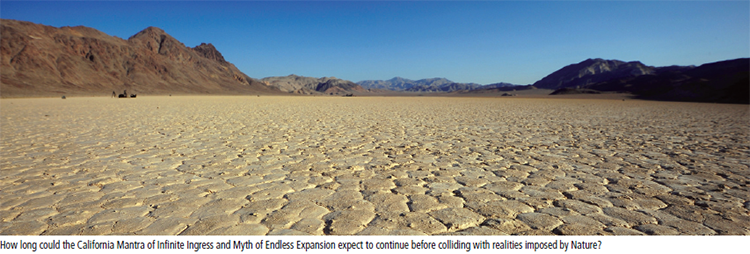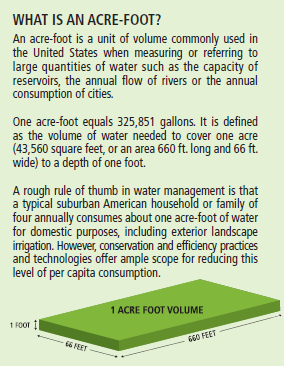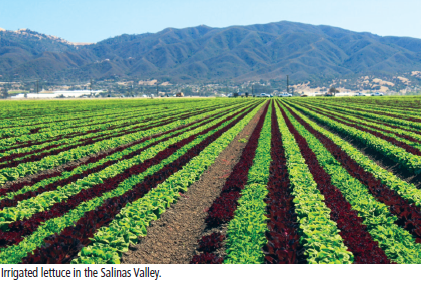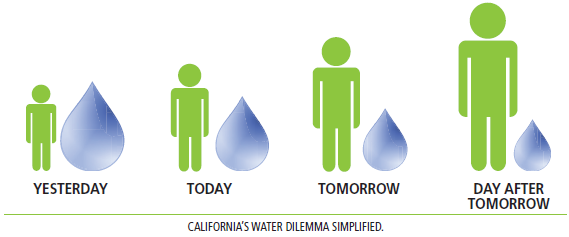California’s Epic Drought: A Shortage of Water or a Longage of People? State has 39 million people … and counting … give or take a few
Published on June 2nd, 2015
PDF Download: caps-issues-epic_drought_-_6-1-2015.pdf
By Leon Kolankiewicz, CAPS Senior Writing Fellow
June 2015
A SPECIAL STATE. California, as every Californian and indeed every American and many foreigners know, is in a class by itself. It is a state of superlatives and extremes. With 39 million residents, it is far and away the most populous—and overpopulated—state in the country; 12 percent of the U.S. population, or one in every eight Americans, live here. It is also the nation’s most lucrative agricultural state in terms of the monetary value of its agricultural production—more than $30 billion annually—double that of its nearest rival, Texas.

 To support its colossal population and its agricultural empire, California also consumes more water by far than any other state. In 2010, according to the U.S. Geological Survey, it accounted for approximately 11 percent of total U.S. water withdrawals and 10 percent of freshwater withdrawals, predominantly for irrigation. Once again, California’s closest rival was Texas, which accounted for about 7 percent of total withdrawals.
To support its colossal population and its agricultural empire, California also consumes more water by far than any other state. In 2010, according to the U.S. Geological Survey, it accounted for approximately 11 percent of total U.S. water withdrawals and 10 percent of freshwater withdrawals, predominantly for irrigation. Once again, California’s closest rival was Texas, which accounted for about 7 percent of total withdrawals.
California withdrew more freshwater from the ground than any other state, accounting for 16 percent of the national total. Crop irrigation accounted for 76 percent of California’s total surface freshwater withdrawals in 2010. California produces more than 400 crops on nearly 82,000 farms, covering some 25 million acres. For some crops, California is the only state in which they are cultivated commercially in the entire country; almonds, artichokes, avocados, dates, figs, raisins, kiwifruit, olives, clingstone peaches, pistachios, dried plums, pomegranates, sweet rice and walnuts are grown in commercial quantities only in California.
Overall, California grows nearly half of the nation’s fruits, vegetables and nuts. Its leading agricultural commodity is milk and cream, accounting annually for nearly $6 billion in cash receipts; the second leading commodity, grapes, accounts for $3.2 billion in cash receipts every year. California was second among the states (after Florida) in saline surface water withdrawals, primarily to cool coastal nuclear power plants at places like Diablo Canyon, San Onofre, Bodega Bay and Humboldt Bay.
A CALIFORNIA WATER PRIMER
The 2013 update of the Department of Water Resources’ California Water Plan contains a wealth of information concerning water use in the state. In an average water year, prior to the current drought, California used to receive nearly 200 million acre-feet of water from precipitation and imports from Colorado, Oregon and Mexico.
 About 50 to 60 percent of this total supply was used by native vegetation, evaporated back to the atmosphere, furnished some of the water for agricultural crops and artificial or managed wetlands (referred to as effective precipitation), or flowed to Oregon, Nevada, the Pacific Ocean and “salt sinks” like saline groundwater aquifers and the Salton Sea.
About 50 to 60 percent of this total supply was used by native vegetation, evaporated back to the atmosphere, furnished some of the water for agricultural crops and artificial or managed wetlands (referred to as effective precipitation), or flowed to Oregon, Nevada, the Pacific Ocean and “salt sinks” like saline groundwater aquifers and the Salton Sea.
The remaining 40 to 50 percent, identified as dedicated or developed water supplies, was distributed among urban and agricultural uses for protecting and restoring the environment, or as storage in surface water and groundwater reservoirs for later use.
In any given year, some of the dedicated supply included water that was used many times (reused water) and water that was held in storage from previous years. Ultimately, about one-third of the dedicated supply flowed to the Pacific Ocean or to other salt sinks. In part this is to meet water requirements for designated Wild and Scenic Rivers and other “in-stream” environmental requirements and objectives.
In order to conserve and utilize its large but limited water resources, California has developed one of most sophisticated water capture, storage and distribution systems anywhere in the entire world to bring water from where nature puts it to where plants and people need it. It is, in essence, a vast and intricate array of “plumbing”— consisting of reservoirs, aqueducts, pipelines and even underground storage (in aquifers). Rainfall and snowmelt in the Sierra Nevada and other mountain ranges are captured and stored in reservoirs and then distributed elsewhere in the state to agricultural and urban areas.
Precipitation usually falls in California only during the winter and spring months, from October through May. The northern half of the state has higher precipitation than the southern half. Summers are dry throughout the entire state. Precipitation falling as snow in the Sierra and other mountain ranges melts throughout the summer and flows into the network of reservoirs and surface water canals, aqueducts and ditches that supply the rest of state.
More than 850 million acre-feet of groundwater, enough to cover California to a depth of eight feet, is stored in 450 known underground reservoirs or aquifers. Here, as in many places around the world, the large stock of water hidden out of sight deep beneath the ground surface has given rise to the myth that groundwater is a renewable resource which can be tapped without limit. But this is false. For one thing, not all groundwater is usable; over half is unavailable due to poor quality and the high cost of pumping it from deep underground.
Groundwater is a crucial component of California’s water supply. During a normal year, about 30 percent of the state’s water supply comes from underground aquifers. In times of intense or prolonged drought, such as the one now in its fourth year, groundwater consumption can increase to 60 percent or more of the state’s total freshwater consumption.
While surface water is concentrated mostly in the northern part of the state, groundwater is more evenly distributed. The largest groundwater reserves are found in the Central Valley, the large, flat valley that dominates the geographic center of California. This great valley, ranging from 40 to 60 miles wide and approximately 450 miles long, is perhaps the single most important agricultural area of its size anywhere in the whole world.
Though California has laws governing surface water usage and quality, there are no statewide laws governing groundwater management. For all practical purposes, land ownership implicitly carries the right to essentially unlimited groundwater pumping, and this sense of entitlement contributes to overpumping or overdrafting. “If I don’t use it, my neighbors will.” It is classic “tragedy of the commons.”
While the volume of groundwater in California is deceptively large, aquifers can readily be overdrafted when groundwater is pumped more rapidly than it is replenished. In 1999, it was estimated that the average, annual overdrafting was around 2.2 million acre-feet across the state, with 800,000 acre-feet in the Central Valley alone. Since then, overdrafting has worsened considerably.
 Recent measurements by NASA’s Gravity Recovery and Climate Experiment (GRACE) satellites found that in just the combined Sacramento and San Joaquin River basins alone, the northern and southern areas of the Central Valley, overdrafting between 2011 and 2014 was 12 million acre-feet of water per year. This accelerated pumping occurred in order to keep agricultural operations going in spite of the deepening drought, which is curtailing deliveries of surface water for irrigation. In the three satellite images shown from NASA and the Jet Propulsion Laboratory, colors progressing from green to orange to red signify accumulating water loss between June 2002 and June 2014.
Recent measurements by NASA’s Gravity Recovery and Climate Experiment (GRACE) satellites found that in just the combined Sacramento and San Joaquin River basins alone, the northern and southern areas of the Central Valley, overdrafting between 2011 and 2014 was 12 million acre-feet of water per year. This accelerated pumping occurred in order to keep agricultural operations going in spite of the deepening drought, which is curtailing deliveries of surface water for irrigation. In the three satellite images shown from NASA and the Jet Propulsion Laboratory, colors progressing from green to orange to red signify accumulating water loss between June 2002 and June 2014.
California’s groundwater is threatened not just by overdrafting and depletion, but contamination as well. In one recent egregious case, in the fall of 2014, it was reported that state officials had inadvertently allowed oil and gas companies to inject nearly 3 billion gallons of hydrofracking wastewater into aquifers that could have been used for drinking water or irrigation.
During fracking operations, drillers use huge amounts of water—up to 5 million gallons per well—to crack open fissures and force the release of crude oil and natural gas tightly bound in impermeable shale formations. This practice results in similarly large quantities of contaminated water, or wastewater, which must then be disposed of somehow. Usually, companies reinject the wastewater deep underground into the same formations from which the fossil fuels were extracted. However, sometimes reinjection takes place into shallower aquifers deemed “exempt” by the EPA, because their water was naturally not clean enough to be usable for irrigation or municipal purposes.
But in a September 2014 letter to the EPA, the State Water Resources Control Board admitted that as a result of permitting errors, in the case of at least nine injection wells, fracking wastewater was reinjected into “non-exempt” aquifers, that is, clean ones with usable, high-quality water. In one case near Bakersfield, as many as 40 water supply wells, including domestic drinking wells, were located within one mile of a single wastewater well that was injecting into non-exempt aquifers. Now local residents are afraid to drink from their water supply wells—in the middle of a ruthless drought—precisely when they are most needed.
PROLONGED DRY SPELL OR MEGA-DROUGHT?
California is currently in the clutches of the worst drought in its recorded meteorological history, which dates back more than a century. Indeed, according to a new study based on tree ring analysis published by researchers working with the American Geophysical Union, the drought now punishing the state is the worst in more than 1,200 years.
Their research shows that the current drought is driven both by reduced though not unprecedented precipitation and record high temperatures. Because of low river flows, depleted reservoirs, reduced surface water deliveries and dropping aquifers, farmers and landowners are drilling more and deeper wells in a frantic effort to continue supplying water and keep their operations, jobs and livelihoods alive.
LAND SUBSIDENCE IN THE SAN JOAQUIN VALLEY (SOUTHERN CENTRAL VALLEY)
In response, groundwater tables are dropping at an unparalleled rate. Water levels in many of the state’s key aquifers—those tapped by municipalities in coastal Southern California and by Central Valley farmers—fell 50 feet or more between spring 2013 and spring 2014. This widespread fall instigated farmers and landowners to drill ever-deeper holes in the ground to reach the receding water table. Central Valley wells that used to hit water at 500 feet below ground surface must now be drilled down to 1,000 feet or more, at a cost that can exceed $300,000 for a single well.
As aquifers are depleted in the Central Valley—and sediments and rock strata drained of the water that helped give them structure, volume and rigidity—the land surface begins to sink or subside.
Land subsidence occurs as a result of large quantities of groundwater being extracted from certain types of rocks, such as fine-grained sediments. The rock layers compact because the water is partly responsible for holding the ground up. When the water is withdrawn, the rock collapses on itself and shrinks.
A 2013 USGS study found that land subsidence in the San Joaquin Valley reached nearly one foot per year at one site. This subsidence in turn is reducing the gradient and flow capacity of the Delta-Mendota Canal and the California Aqueduct, two major sources of water for the Central Valley and Southern California.
Because canals are built with a small slope to help propel the water by gravity, differential land sinking can change that slope in random areas and thus impact flows. The USGS study reported that canals are not the only infrastructure at risk from subsidence. Railways, roads and pipelines—all linear structures that extend over a long distance—are also under threat.
As in many Western states, water and water rights are among California’s most divisive political issues. With most of the state lacking rainfall in the dry season, water is limited in the most populous, and ever more overpopulated, U.S. state. An ongoing debate, at least prior to the current drought, was whether the state should increase the distribution of water to its large agricultural and urban sectors, or increase conservation and preserve the natural ecosystems of water sources.
With the prolongation of the most severe drought in California’s recorded history, natural ecosystems and the species that reside in them are losing out to ever more anxious business, urban and agricultural interests. Now the debate has morphed into whether agriculture needs to forfeit its grip on most of the state’s water and relinquish more of it to cities, so the cities can continue their addiction to growth. California’s movers and shakers worship at the altar of perpetual growth; it is this secular state’s de facto religion. And now the Central Valley’s thirsty almond crop has become a popular scapegoat and punching bag of the growth-at-all-costs crowd.
Because of the threat to critical water supplies posed by California’s drought, on January 17, 2014, Governor Jerry Brown declared a State of Emergency that suspended the California Environmental Quality Act (CEQA) and state water quality plans with regard to actions to make water immediately available. According to the declaration, they were “suspended on the basis that strict compliance with them will prevent, hinder, or delay the mitigation of the effects of the emergency.”
After still another winter of feeble precipitation in 2014-2015, the Sierra Nevada snowpack and the state’s huge reservoirs are at historic lows. At the same time, scientists are warning of the possibility of an incipient “megadrought” that could last decades. In March 2015, Governor Brown declared statewide mandatory water restrictions for the first time in California’s history, ordering towns and cities to reduce their water use by 25 percent. This will be an enormous challenge, but if the severity of the drought continues, it may not be enough to stave off truly dire consequences for the state.
Yet at the same time, California’s governor and chief cheerleader is a gushing immigration enthusiast who eagerly welcomes any and all newcomers to his state, legal and illegal alike. Both in his earlier incarnation as a Zen master and “Governor Moonbeam” in the 1970s and his recent governorship, Brown enjoys prattling on about the imperative of embracing limits, except when it comes to population growth, about which apparently he countenances no limits.
But in the real world, as opposed to this dreamer’s utopia, the fact that California already has 39 million residents, and continues to add millions more every decade, surely has some bearing on whether there is enough water to go around. For cornucopians of Brown’s ilk, admitting that the predicament may be more a “longage” of people than a shortage of water (in Garrett Hardin’s memorable turn of phrase) is apparently beyond the pale.
The severity and tenacity of the current drought has goaded many Californians to seriously consider or reconsider desalination as at least a partial solution to the state’s water woes. A $1 billion desalination plant is on the verge of completion at Carlsbad in San Diego County; when ready it will deliver about 50 million gallons a day of potable water to residents of San Diego County at a cost about twice that of conventional water supplies.
The most commonly used desalination technology—reverse osmosis—entails forcing seawater through a membrane with tiny holes that allows the passage of water molecules, but impedes the flow of larger salt molecules. The pressure needed to accomplish this requires a large amount of electrical energy, although energy use has been reduced through technological improvements.
Still, if fossil fuel-derived electricity is used, desalination will emit carbon dioxide, exacerbating climate change. One future prospect is using wind or solar power to drive reverse osmosis, reducing or eliminating CO2 emissions. Two other environmental problems associated with desalination are adverse effects on marine life from the intake of seawater, which can kill fish eggs and larvae, and the disposal of extracted salt or brine from seawater back into the ocean.
WHITHER CALIFORNIA? WITHER CALIFORNIA?
California, with the largest population and the largest agricultural sector in the entire country—and now with its particularly pressing water conflicts and challenges—represents a laboratory of sorts for the rest of the country and the world. One certainty is that continued population growth in California will only aggravate and intensify the state’s water shortages.
The drought is forcing at least some Californians to entertain the heretical notion that endless growth for the sake of growth may not be possible or desirable—the ideology of the cancer cell, as Southwest writer Edward Abbey famously put it. But this same drought is encouraging the state’s Establishment, both Democratic and Republican—those who worship at the altar of perpetual growth—to double down in their shrill calls for sacrificing agriculture and the environment on that altar. It’s reminiscent of a desperate balloonist jettisoning ever more ballast to keep a sinking hot air balloon aloft.
Former Hewlett-Packard executive and Republican politician Carly Fiorina blames liberal environmentalists who courageously fought still more dams on the state’s rivers and had the audacity to defend a tiny fish (the Delta smelt) from extinction for California’s “man-made” drought.
The irony is that, to the extent the drought is a byproduct of anthropogenic climate change, it is at least partially man-made, but not in the sense Fiorina intended.
 When California is besieged with 80 million residents residing in one sprawling, blighted megalopolis without end; when the state has all but lost its farms, its charms, its rivers, hundreds of endangered species, and any semblance of that quintessential California quality of life, the growth zealots still will be looking for things to sacrifice to keep the growth gig going. The saying “enough is enough” isn’t good enough for them.
When California is besieged with 80 million residents residing in one sprawling, blighted megalopolis without end; when the state has all but lost its farms, its charms, its rivers, hundreds of endangered species, and any semblance of that quintessential California quality of life, the growth zealots still will be looking for things to sacrifice to keep the growth gig going. The saying “enough is enough” isn’t good enough for them.
In the early 1990s, I had the pleasure of meeting Marc Reisner, author of the environmental classic Cadillac Desert: The American West and Its Disappearing Water, at an environmental conference in Southern California, where he had spoken. I asked Reisner what he thought California’s population boom meant for its limited water resources, and vice versa; I don’t remember his specific response, but I do remember he agreed that overpopulation was a serious issue.
Sadly, Reisner died in 2001 of colon cancer at the age of just 51 at his home in San Anselmo, in the heart of picturesque Marin County, north of San Francisco. But he left behind an indelible legacy with his captivating and compelling history of the most precious natural resource in the West. One of the things that gave Cadillac Desert its enduring appeal was Reisner’s long-term perspective:
“When archaeologists from some other planet sift through the bleached bones of our civilization, they may well conclude that our temples were dams. Imponderably massive, constructed with exquisite care, our dams will outlast anything else we have built….”
CAPS Senior Writing Fellow Leon Kolankiewicz is an environmental scientist and planner.




